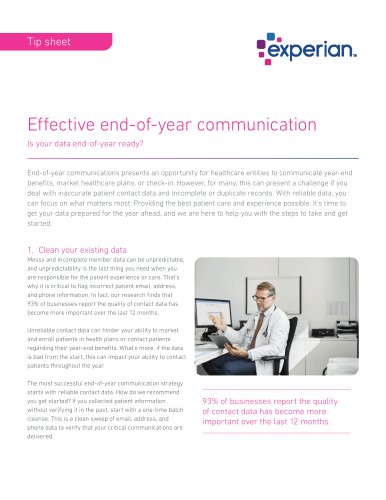- Products

Enjoy a free 30-day trial of our
data validation software.Experience the power of trusted data
solutions today, no credit card required! - Solutions

Enjoy a free 30-day trial of our
data validation software.Experience the power of trusted data
solutions today, no credit card required! - Partners

Enjoy a free 30-day trial of our
data validation software.Experience the power of trusted data
solutions today, no credit card required! - Learn more
- Pricing
- Contact Us
Effective end-of-year communication for healthcare
Effective end-of-year communication for healthcare: is your data end-of-year ready?
End-of-year communications present an opportunity for healthcare entities to communicate year-end benefits, market healthcare plans, or check-in. However, for many, this can present a challenge if you deal with inaccurate patient contact data and incomplete or duplicate records.
With reliable data, you can focus on what matters most: Providing the best patient care and experience possible. It’s time to get your data prepared for the year ahead, and we are here to help you with the steps to take and get started.
1. Clean your existing data
Messy and incomplete member data can be unpredictable, and unpredictability is the last thing you need when you are responsible for the patient experience or care. That’s why it is critical to flag incorrect patient email, address, and phone information. In fact, our research finds that 93% of businesses report the quality of contact data has become more important over the last 12 months. Unreliable contact data can hinder your ability to market and enroll patients in health plans or contact patients regarding their year-end benefits. What’s more, if the data is bad from the start, this can impact your ability to contact patients throughout the year. The most successful end-of-year communication strategy starts with reliable contact data. How do we recommend you get started? If you collected patient information without verifying it in the past, start with a one-time batch cleanse. This is a clean sweep of email, address, and phone data to verify that your critical communications are delivered.
2. Collect accurate member data as part of an ongoing process
While seasonality can account for when large amounts of data are entering your database, access to trustworthy contact data is a year-round need. Consider leveraging real-time verification software, both in-person and online, to benefit the efficiency of your healthcare entity and protect the patient experience. For example, Experian’s Address Validation features can reduce the number of keystrokes by up to 80%, ultimately speeding up your operations process and removing friction from the digital or mobile experience. That way, as data is entering your database, whether it’s from a call-center, in-person check-in, or webform, you can make sure that valid data successfully enters from the start and avoid any scrambles in preparation for end-of-year communication. Don’t have access to front-end patient entry points? Consider scrubbing incoming roster data before initial load, and on a quarterly basis, to ensure you always have the most complete and up-to-date information.
3. Complete your patient contact records
Once you understand the accuracy of contact data across patients, make sure you have a complete view of your members by appending missing information such as email and phone number. We can even help you identify the best email across your members since it’s not uncommon for an individual to have multiple email addresses. That way, you can know the most effective way to reach out with critical information. For example, if you are running a marketing campaign to patients prior to open enrollment season, knowing the email address that is most likely to get a response can be invaluable information. With complete patient contact records, you can be more certain that your messaging will reach its intended audience.
